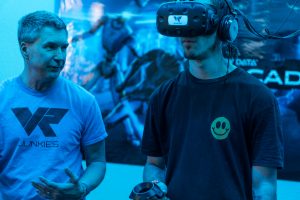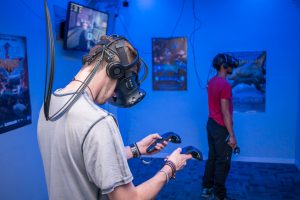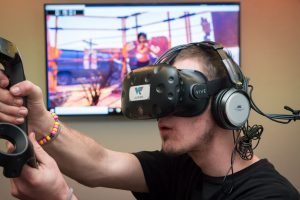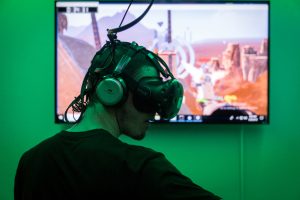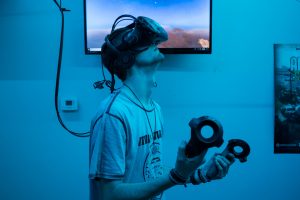- Slug: BC-CNS-VR arcades About 1,240 words.
- Photos available (thumbnails and captions below)
By TRISTAN ETTLEMAN
Cronkite News
TEMPE – Four virtual reality arcades have popped up in metro Phoenix as players who can’t afford the emerging technology at home are willing to pay for a few immersive minutes of horror or military-style firefights.
The steep cost of headsets, space limitations and inexperience with the technology have created a VR arcade industry that caters to consumers seeking new experiences. Still, the handful of arcades that have opened in Phoenix in the past two years pale in comparison to the numbers on the East and West coasts and in such countries as China.
Although one expert estimates the global VR business in homes and businesses could reach $48.5 billion and touch multiple industries, including health care and defense, in less than a decade, the nascency of VR makes it uncertain whether the group experiences of today’s arcades have staying power.
Space pirates and horror shows
Grasping their Groupons, VR novices Joy Jones and Davon Donaldson walked into VR Junkies arcade in Tempe, ready to be teleported into space. A VR arcade is quiet, unlike the bright lights and loud pings of traditional arcades, and it’s punctuated by customers’ exclamations as they navigate a virtual world.
Jones stood in front of a television screen that displayed the space-pirate game she would see in her HTC Vive headset. She strapped on one of the eight headsets dangling from the ceiling. Tiny cameras in the player space acted as movement-sensing “lighthouse” sensors above her, creating invisible, infrared walls.
Lighthouse sensors allow players to walk, twist, turn and duck to avoid obstacles and move within a limited space. Virtual walls ensure players don’t bump into real ones, and certain games “teleport” players through a virtual world while they stay tethered to a small, real-world space.
Inside the Space Pirate Trainer game, Jones wielded a laser pistol in each hand – holding two controllers in reality – as she blasted hordes of droids.
Jones called it typical video game action except for the deep immersion.
But Donaldson said the game and technology were more impressive than he expected.
“I thought it was going to be a bit cheesy, but it was actually pretty cool,” he said.
The best VR experience, fans say, is too difficult to explain. You have to try it to fully understand.
At VR Junkies and other arcades, customers typically pay $1 per minute, playing for at least five minutes and as much as 45 minutes. Most VR games are first-person shooters or horror experiences, but sports and casual games are also available.
Jones and Donaldson said they didn’t experience the most common detractor for VR: motion sickness.
“I have seen videos of people falling all out,” Jones said. Donaldson added the motion sensors that indicate physical walls was helpful.
The two said they enjoyed themselves but wouldn’t be purchasing a headset for home anytime soon. With at least an $800 investment for the industry’s least expensive but still high-quality system, brief arcade experiences are enough for now.
“If they lower the prices down,” Donaldson said, he can see VR becoming more popular for home use.
Striving to build a real-world business
The operators of VR Junkies and Velocity VR in Scottsdale said their business is growing.
Owner Tawn Makela said 700 unique customers have played at VR Junkies since she and her husband, Chris Krakowski, took over the Tempe store in September. On a recent weekend, 52 customers played at the store.
“I absolutely believe we have seen some growth,” she said.
Still, revenue is a challenge. The high cost of rent on Tempe’s Mill Avenue spurred them to move to Chandler Fashion Center, where they will reopen soon.
The store is “not quite breaking-even monthly,” Makela said.
The couple has invested about $100,000 and have to pay licensing fees to developers for each minute of their games played, with the highest fee at 12 cents a minute.
JP Mullan, general manager of the go-cart track Octane Raceway and Velocity VR, which is housed inside, said Velocity’s technology is proprietary and can’t be purchased online.
Velocity VR showcases VR “experiences” that can only be played in the arcades, while places like VR Junkies offer glimpses into what can be had at home.
Up to eight players can play group shooting games at Velocity VR.
Mullan said about $800,000 was invested into Velocity VR, and operation costs range from $50,000 to $100,000 a month. At $45 a session per person, Mullan said the venture is on its way to becoming profitable.
Velocity VR saw about 1,000 customers its first month, and for each of the past few months, about 2,000 customers. Mullan said the experience’s price point and the availability of the play space every 30 minutes affects attendance.
Competition at home
Much like Netflix and other streaming services brought down the cost of watching television and led to declining movie theater revenue, the potential for technology becoming cheaper may mean more home ownership and less VR playing in public spaces, some experts say.
But Makela doesn’t think the rise of home VR systems will put arcades like hers out of business. Most people won’t be able to soon afford a high-quality experience at home, she said, and even then, the space and communal experiences an arcade offers will keep the business solvent.
Mullan also isn’t concerned about at-home technology and decreasing costs for consumer ownership.
“In a year, they may be doing something similar,” he said, but the space and number of headsets required for something like Velocity won’t affect its business. Besides, he said, the company has proprietary technology that isn’t available for sale online to at-home users.
According to website VRnish, the U.S. has about 120 VR arcades and experiences. The VR arcade business in metro Phoenix is small compared with larger areas, such as New York, with 13 arcades, and Los Angeles, which has 14 arcades, VRnish said. But China has more than 3,000 VR arcades, Vive executive Alvin Wang Graylin said in a 2016 interview with VRroom.buzz.
Data on the industry, and particularly the nascent VR arcade industry, is difficult to pin down. But,
according to Grand View Research, the global VR industry will be worth $48.5 billion by 2025.
Sales for home-use VR headsets have now passed 1 million, according to industry analyst Canalys.
Oculus Rift and HTC Vive, considered among the costliest and highest quality VR headsets, run for $400 and $600, respectively, but they need to be connected to powerful computers that can cost $1,000 or more.
Gaming is the major component of the industry, but Grand View Research also cites gains in medical, industrial, aerospace and defense applications of the technology.
One VR simulation allows users to speak with virtual people with substance-abuse problems, suicidal thoughts or other psychological stresses, Forbes reported in August.
Virtual reality advancements have a history in the military and defense industry, where applications often are used to simulate flight, medic training and battlefield situations.
For more stories from Cronkite News, visit cronkitenews.azpbs.org.
^__=
